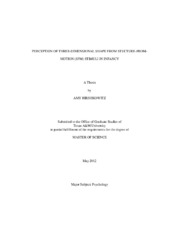| dc.contributor.advisor | Wilcox, Teresa | |
| dc.creator | Hirshkowitz, Amy | |
| dc.date.accessioned | 2012-07-16T15:57:41Z | |
| dc.date.accessioned | 2012-07-16T20:23:02Z | |
| dc.date.available | 2014-09-16T07:28:18Z | |
| dc.date.created | 2012-05 | |
| dc.date.issued | 2012-07-16 | |
| dc.date.submitted | May 2012 | |
| dc.identifier.uri | https://hdl.handle.net/1969.1/ETD-TAMU-2012-05-10775 | |
| dc.description.abstract | Three-dimensional (3D) object perception is critical for comprehending and interacting with the world. It develops during infancy and continues through adulthood. One powerful cue used for object perception is uniform coherent motion. The present paper first briefly reviews the current literature concerning object perception using random-dot stimuli and structure-from-motion (SFM) displays. To extend our knowledge in this area, two new studies were conducted to further our understanding of how infants process 3D shape in SFM stimuli.
Study 1 examined infants of two age groups (3-5 month-olds and 8-9 month-olds) in a familiarization phase and a test phase. In the familiarization phase, infants were exposed to one of two SFM shapes (cube or cylinder) and in the test phase infants viewed both SFM shapes side-by-side. Extraction of shape was measured through novelty preferences. Results of Study 1 suggest that both age groups successfully extracted 3D shape. Study 2 served as a replication and extension, with the added control for the variable rotational axis. When this variable was controlled for, 3-5 month-olds failed to show a novelty preference during the test phase. These results suggest not only that infants were attending to both the global shape presented in the SFM stimuli as well as the detailed component of the rotational axis of the stimuli, but also that adding the extra change in the component of rotational axis to SFM stimuli makes the task of extracting shape more difficult for infants. These findings contribute to the infant literature by furthering the understanding of infant shape perception. | en |
| dc.format.mimetype | application/pdf | |
| dc.language.iso | en_US | |
| dc.subject | Infancy | en |
| dc.subject | Shape Perception | en |
| dc.subject | Structure-from-motion | en |
| dc.title | Perception of Three-Dimensional Shape from Structure-from-Motion (SFM) Stimuli in Infancy | en |
| dc.type | Thesis | en |
| thesis.degree.department | Psychology | en |
| thesis.degree.discipline | Psychology | en |
| thesis.degree.grantor | Texas A&M University | en |
| thesis.degree.name | Master of Science | en |
| thesis.degree.level | Masters | en |
| dc.contributor.committeeMember | Alexander, Gerianne | |
| dc.contributor.committeeMember | Gabbard, Carl | |
| dc.type.genre | thesis | en |
| dc.type.material | text | en |
| local.embargo.terms | 2014-07-16 | |


